- See also Pinhey's Point Historic Site

Hamnett Kirkes Pinhey (11 December 1784 – 3 March 1857) was a Canadian landowner and politician.

Hamnett Kirkes Pinhey (11 December 1784 – 3 March 1857) was a Canadian landowner and politician.
Pinhey was born in Devonshire, England, in 1784 to Mary Townley and William Pinhey. He was educated at Christ's Hospital in London and became a grocery and insurance merchant, a partner in Pinhey and Crosley: Merchant and Ship Insurance Brokers. Pinhey spoke fluent French and German, and was a King's messenger who also claimed to have been a secret spy of the Crown to the King of Prussia during the Napoleonic Wars. By the age of 35, Pinhey had made enough money to retire comfortably from business.
Pinhey married Mary Ann Tasker on 12 December 1812.
Hamnett Pinhey was now a wealthy middle-class man, but thanks to the class system in place in England at the time, Pinhey was not able to gain the power or privilege he desired. Seeking greener pastures, Pinhey petitioned the Earl of Bathurst, Secretary of State for War and the Colonies at the time, for lands in Upper Canada and received a land grant. Originally, Pinhey requested 1,200 acres (4.9 km2). He was granted 200.
In 1820, Pinhey travelled to March Township in Upper Canada and settled at a site on the Ottawa River. He and his clerk spent the first winter in a one-room log cabin, but soon built a larger one and half story log house and stone kitchen. His wife, children and possessions followed in 1821. With the family came 55 crates with clothing, plate, furniture, books and other items to allow the family to live comfortably in Upper Canada.

Pinhey established himself as a gentleman farmer on his land and named this location Horaceville after his eldest son. Though he began building with the log house, Pinhey had always intended to build a large stone house on top of the hill, overlooking his land. The first part of the stone house was completed in 1825, and consisted of a large Parlour for entertaining and the servants quarters on the second floor. The second part of the house was not completed until 1841, and included the Grand Entrance, the original Dining Room, the Master Bedroom and a second stone kitchen for Mrs. Pinhey. By this point Horace Pinhey had married and moved into the log house with his wife. The last part of the stone house was completed in 1848, and housed Hamnett's Library, the Drawing Room, several bedrooms for the family and Hamnett's Sanctum Sanctorum (the Holiest of Holies, a second floor indoor privy.) Though the house was built in three different stages, it was designed as a whole in a symmetrical Georgian fashion.[ citation needed ]
In addition to the house, Pinhey built a grist mill, sawmill, and St. Mary's Church on the site. Although the first service in the church was held on 7 October 1827, it was not consecrated until 1834 due to a dispute about the church's location with the ruling bishop at the time.[ citation needed ]
The Pinhey family continued their British aristocratic values at Horraceville. Other former members of the British military moved into March Township, and the group has been described as "Ottawa's original aristocracy." [1] Pinhey was recognized as the leader of this group, and Horaceville served as its chief community. Pinhey welcomed members of the British elite into his home, including Lord Dalhousie and Upper Canada Anglican Bishop John Strachan. Pinhey also managed a full staff at his home including footmen and a butler. Pinhey's wife insisted on being carried to their family chapel in a sedan chair. [2]
In 1832, Pinhey was elected to the Legislative Assembly of Upper Canada in a by-election in Carleton County. He lost his seat the following year due to voting irregularities in the by-election. Pinhey continued to serve in various positions in local government and, in 1847, became a member of the Legislative Council of the Province of Canada. Pinhey had been governor of Christ's Hospital in London and continued to provide it with financial support.
Hamnett Kirkes Pinhey died in 1857 and was buried in the graveyard at St. Mary's Church. The estate was left to his son, Horace Pinhey.
Members of the Pinhey family lived in the house until 1971. The last member of the family to live in the house was Ruth Pinhey. While she was living in the house, most rooms had been closed off save the old dining room, which she used as a bedroom, and the Grand Entrance, which she used as a living room. Upon her death in 1971, Ruth Pinhey left the estate to a family member, who then sold the property to the township of March.
The former site of the town of Horaceville has been preserved as the Pinhey's Point Historic Site operated by the City of Ottawa and the Pinhey's Point Foundation.

Children of Hamnett Kirkes Pinhey and Mary Ann Tasker
Hamnett Pinhey (1815-1815), Horace Pinhey (1817–1875), Constance Pinhey (1819–1898), Mary Anne Pinhey (1821–1896, Charles Hamnett Pinhey (1828–1893)
Children of Horace Pinhey and Catherine (Kate) Tydd Greene
Mary Anne Eliza Pinhey (1848–1929),Constance Anna Pinhey (1849–1932), Arabella Lucy Pinhey (1851–1905), Hamnett Kirkes Pinhey (1853–1941), Horace Pinhey (1857–1921), Kate Pinhey (1861–1937), Godfrey Greene Pinhey (1859–1910), Charles Townley Pinhey (1863–1879)
Children of Constance Pinhey and John Hamnett Pinhey John Charles Pinhey (1860–1912)
Children of Mary Anne Pinhey and Hamnett Hill (MD)
Hamnett Pinhey Hill (1845–1879), Mary Anne Lucy Hill (1847-1847), Charles Townley Hill (1850–1852), Emily Hill (1959-1945), Caroline Hill (1864–1945)
Children of Charles Hamnett Pinhey and Catherine Lewis
Mary Anne Pinhey (1863–1864), Harold Kirkes Pinhey (1865–1942), Charles Herbert Pinhey (1867–1955), Catherine Lucy Pinhey (1868–1954), Anna Hilda Pinhey (1870–1962)

24 Sussex Drive, originally called Gorffwysfa and usually referred to simply as 24 Sussex, is the official residence of the prime minister of Canada, in the New Edinburgh neighbourhood of Ottawa, Ontario. Built between 1866 and 1868 by Joseph Merrill Currier, it has been the official home of the prime minister of Canada since 1951. It is one of two official residences made available to the prime minister, the Harrington Lake estate in nearby Gatineau Park being the other.

Rideau Hall is the official residence of the governor general of Canada, the representative of the monarch of Canada. Located in Ottawa, the capital of the country on a 36-hectare (88-acre) estate at 1 Sussex Drive. The main building consisting of approximately 175 rooms across 9,500 square metres (102,000 sq ft), and 27 outbuildings around the grounds. Rideau Hall's site lies just outside the centre of Ottawa. It is one of two official vice-regal residences maintained by the federal Crown, the other being the Citadelle of Quebec.
Bytown is the former name of Ottawa, Ontario, Canada. It was founded on September 26, 1826, incorporated as a town on January 1, 1850, and superseded by the incorporation of the City of Ottawa on January 1, 1855. The founding was marked by a sod turning, and a letter from Governor General Dalhousie which authorized Lieutenant Colonel John By to divide up the town into lots. Bytown came about as a result of the construction of the Rideau Canal and grew largely due to the Ottawa River timber trade. Bytown's first mayor was John Scott, elected in 1847.
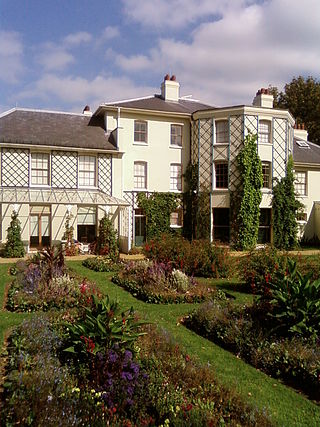
Down House is the former home of the English naturalist Charles Darwin and his family. It was in this house and garden that Darwin worked on his theory of evolution by natural selection, which he had conceived in London before moving to Down.

Richmond is a rural village within the amalgamated City of Ottawa, Ontario, Canada. Founded in 1818, it spans the Jock River, a tributary of the Rideau River. A part of the National Capital Region, Richmond is located 10 kilometres (6.2 mi) southwest of Kanata and immediately south to the community of Stittsville.
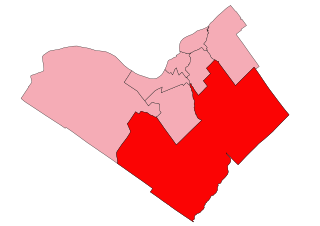
Carleton is a federal electoral district in Ontario, Canada, represented in the House of Commons of Canada from 1867 to 1968 and since 2015. It was represented in the Legislative Assembly of Upper Canada from 1821 to 1840 and in the Legislative Assembly of the Province of Canada from 1841 until 1866. It has been represented by Pierre Poilievre, the current Leader of the Opposition, since its creation in 2015.
Horaceville is a historic site located on the Ottawa River in eastern Ontario, Canada. The site remained the property of the heirs of Hamnett Kirkes Pinhey until the 1970s, when the property was sold to the township. Today, The 88-acre (360,000 m2) heritage site is owned and operated by the City of Ottawa and Pinhey's home serves as a museum. The museum is open May 14 through August 31, Wednesdays to Sundays, 11 am to 5 pm. This location is also known as Pinhey's Point Historic Site. The property was designated by the City of Ottawa under Part IV of the Ontario Heritage Act as having cultural heritage value or interest. A bronze plaque erected on the site by the Ontario Heritage Foundation describes the property's history: "Hamnet Kirkes Pinhey 1784 - 1857 - A merchant and ship owner in his native England, Pinhey came to Upper Canada in 1820. For his services as King's messenger during the Napoleonic Wars, he received a 1000 acres land grant on the Ottawa River. Within a decade he had built up an estate which he named Horaceville after his elder son. In addition to a manor house and barns, it included mills, a store and church. Pinhey took a leading part in township and district affairs. He was appointed to the Legislative Council in 1847, served as Warden of the Dalhousie District, and as the first Warden of Carleton County. Horaceville remained in family hands until 1959 when it was purchased by the National Capital Commission."
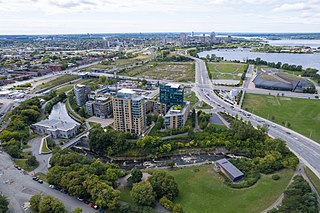
LeBreton Flats, known colloquially as The Flats, is a neighbourhood in Somerset Ward in central Ottawa, Ontario, Canada. It lies to the west of Centretown neighbourhood, and to the north of Centretown West. The Ottawa River forms the western and northern limit, with the western side being a wider area of the river known as Nepean Bay.
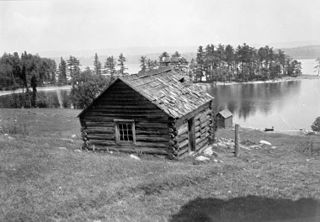
March Township is a geographic township and former municipality originally part of Carleton County in eastern Ontario, Canada. It is currently part of the City of Ottawa. It is located in the western part of the county, bordered to the northwest by Torbolton Township, to the southwest by Huntley Township, to the east by Nepean, to the south by Goulbourn Township and to the north by the Ottawa River. According to the Canada 2001 Census, the Township had a population of approximately 26,650.

The Goddard family were a prominent landed family chiefly living in the northern regions of the English counties of Wiltshire and Hampshire and the western part of Berkshire, between the Tudor period and the early 20th century.

Piney Grove at Southall's Plantation is a property listed on the National Register of Historic Places in Holdcroft, Charles City County, Virginia. The scale and character of the collection of domestic architecture at this site recall the vernacular architectural traditions of the eighteenth, nineteenth and twentieth centuries along the James River.

Hamnett Pinhey Hill was an Ontario lawyer and political figure. He represented Ottawa West in the Legislative Assembly of Ontario from 1919 to 1923 as a Conservative member.
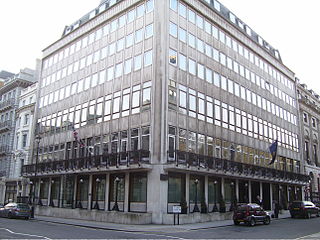
The Army and Navy Club in London is a private members' club founded in 1837, also known informally as The Rag.

The Chase–Lloyd House is a historic house at 22 Maryland Avenue in Annapolis, Maryland. Built in 1769–1774, it is one of the first brick three-story Georgian mansions to be built in the Thirteen Colonies, and is one of the finest examples of the style. Its interiors were designed by William Buckland.
This is a timeline of the history of Ottawa.
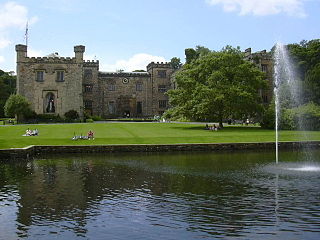
The Towneley or Townley family are an English family whose ancestry can be traced back to Anglo-Saxon England. Towneley Hall in Burnley, Lancashire, was the family seat until its sale, together with the surrounding park, to the corporation of Burnley in 1901. Towneley Hall is now a Grade I listed building and a large museum and art gallery within Towneley Park.
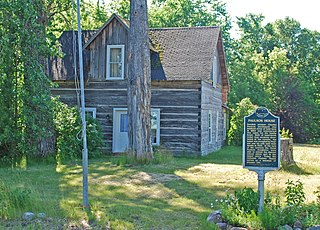
The Paulson House in Au Train, Michigan was built in 1883. It was listed on the National Register of Historic Places and designated a state of Michigan Historic site in 1972.

The Bois Blanc Island Lighthouse and Blockhouse is a National Historic Site of Canada located in Ontario on Bois Blanc Island, one of the islands in the Detroit River. It consists of a lighthouse, owned by Parks Canada, and a blockhouse, which is privately owned.

The Edward Brooke II Mansion (1887–88), also known as "Brookeholm," is a Queen Anne country house at 301 Washington Street in Birdsboro, Pennsylvania. Designed by architect Frank Furness and completed in 1888, it was Edward Brooke II's wedding present to his bride, Anne Louise Clingan.